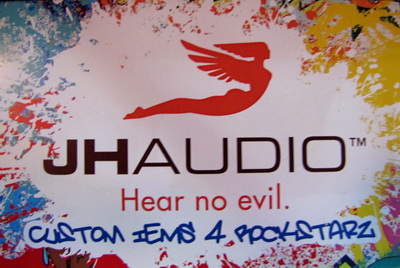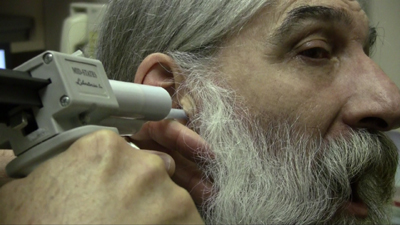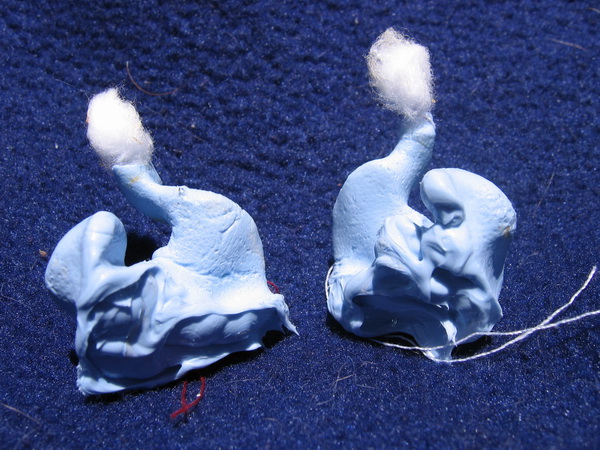| « Grab the Big Ticket for Good Times in Jacksonville | Magnolia Fest 2011 in Review » |
Dan Grigor Gets Shot in the Head
Sound Advice by Dan Grigor
I’ve had another adventure I’d like to share with you. I now have a custom set of JHAudio In-Ear Monitors and I gotta tell you it has been a wild ride but the sound… the sound… it is as clear as a bell. Every nuance, every note, every rest, every breath… it’s like having the band playing the song in your head. It’s like an angel tinkling in your ear.
There is a story though… let me start at the beginning.
Click through to hear all about it . . .
One of the problems with playing an acoustic 12-string guitar live and loud on stage is the age-old problem of feedback. It is fairly easy to eliminate it from the house speakers if you stand behind them, but the floor monitors are a horse of a different color. They face me and tilt up a little at an angle, and if you turn up the volume they squeal. Nobody likes that sound, nobody.
Feedback is caused by a signal loop. When the speaker returns the sound back to the mic, you set up a signal loop that will go on forever until you stop it. Essentially, if you stroke a big E chord and it comes out of the speakers at 100 decibels, then that sound enters the microphone at 100 decibels, it would loop those tones ’til the cows came home. 100 decibels is a lot of decibels. Don’t do that. Trust me.
That is why lead guitar players can manipulate it and use it to solo with. By getting a frequency to feedback you can play around it as if it was a loop station. Use single-note feedback or sliding screaming tones and what you are doing is creating signal loops. Cool for metal heads, not so cool for acoustic music where folks are more likely to be sitting closer to the speakers. Let me say it again, nobody likes that sound. It’s evil.
So what do you do? You can and should use a feedback suppressor on your monitor system anyway. It notches feedbacking frequencies automatically and can help you raise the overall monitor levels. That may work for most stages but if you add an acoustic guitar you may also need a separate EQ unit to control the frequencies specifically for the guitar channel or to restore tone to a mix that is notched too much.
It shouldn’t change the house mix other than “monitor overflow” in the first few feet off the stage. It can make a huge difference to the show if everyone on stage can hear what is going on. Traditionally we have several “mixes” on stage. The drummer may want one mix and the lead vocalist another, while the bass player wants a completely different mix of sounds in his head cause who knows what bass players think.
We often modified our old snakes so you could have a separate monitor mix on stage. I have one. It can send the same signal to both the house and the monitor mixers. Each mixer can have completely different settings and that leaves all onboard monitor or aux systems for recording a third mix. So you can have one mix for the house, split signals on a stereo mixer for the monitors with several mixes available and one dry mix with no effects right to the recorder. If you include crowd mics on the recorder mixer you have a completely dry copy of your live show with no effects. Post processing on that would allow a whole new mix on the final audio or video. That way you can make it perfect while editing, and when it’s done it is better than actual live sound. You have total control of the sonic landscape, so the variables of the live environment play a much smaller role in the final production.
Still, no matter how smart your snake is, how expensive your rig is, or how much you try, acoustic guitars are prone to feedback and will do so the moment you have declared the system feedback free. I guarantee it. The real answer is GET OFF THE FLOOR. It is a new world. Floor monitors are so eighties anyway. The “shirt off, foot on the monitor, hold the mic with two hand and make the girls swoon” days are over. Now you need a cute haircut and chucks with dress pants. No one can see those behind floor monitors. They are useless to hold back rabid fans and I have been known to trip over them. I have video of a jam where the bass player fell over a monitor and off the stage. He landed on his back and managed to save his guitar. All the while, two of his brothers and I kept playing while peeking over the edge to see if he was all right. It is hilarious. Don’t be that guy. Get an IEM.
It isn’t just acoustic players that have the feedback problem. With cordless mics, sound guys can’t keep you on a leash anymore. Hip-Hop dudes and rappers, MCs, ring announcers and wedding DJs, everyone these days feels free to run around the stage waving a hot mic around. Or how about the guy that forgets where he is and drops to one knee and croons right in front of a big ‘ol floor monitor. When his ears, and everyone else’s, are assaulted by the squeal, they always look back toward the sound guy as if the signal loop is somehow his fault. Don’t be that guy; you look like an idiot. Get an IEM.
So, with all that in mind, let me take you through the process. A custom IEM isn’t like the earbuds that come with your ipod. A custom-fitted IEM uses impressions made of your ear canal to form a mold from which your IEM is made. It fits exactly into your ear and no one else’s. Talk about noise cancellation! When you have them in and not plugged in they are a really expensive set of earplugs. It is difficult to hear room noise. You only hear what comes through the IEM itself. Although my wife’s laugh cuts through; if you know her, you know why.
So the first step is to get impressions, or molds, made of your ear canals. You then send the molds to the company producing the IEMS and they make your custom set and send them back to you.
It is kind of expensive in that you need to see an audiologist for the impressions and the IEM itself is a little pricier than a set of headphones. If you are a real audiophile, a professional musician or even just an amatuer acoustic guitar guy playing local shows in bars, you owe it to yourself to get this done. You will never look back and never feedback again… until the next time and it will be for some other reason entirely.
I have video of the audiologist and an interview with the JH of JHAudio, Jerry Harvey. I’ll be posting an episode a week until we try them out on stage and you can see me hug a monitor with my guitar on with no feedback whatsoever. Stay Tuned! You don’t want to miss this.





